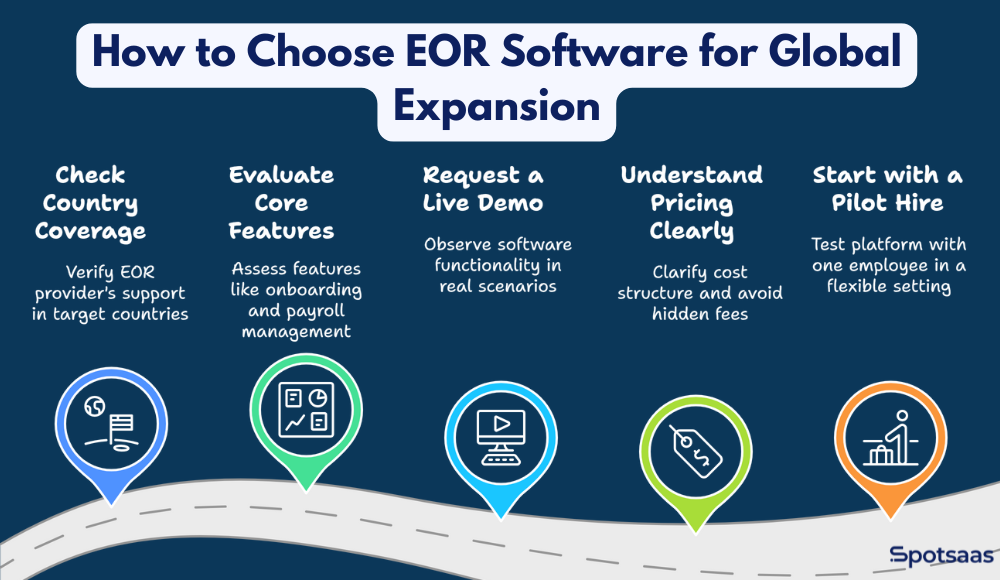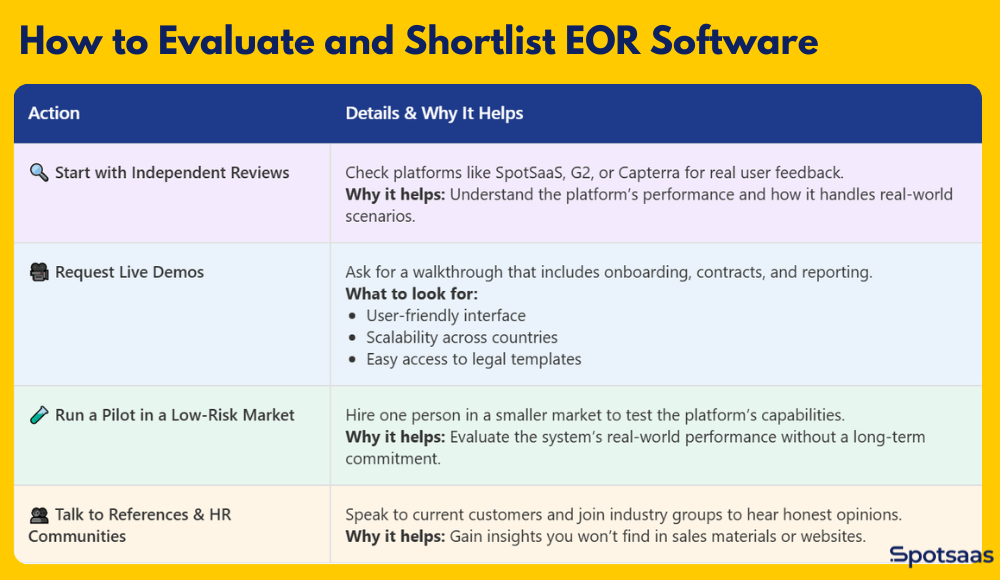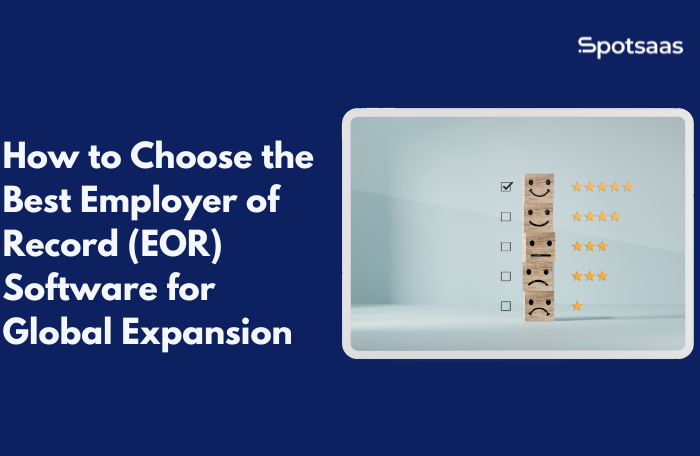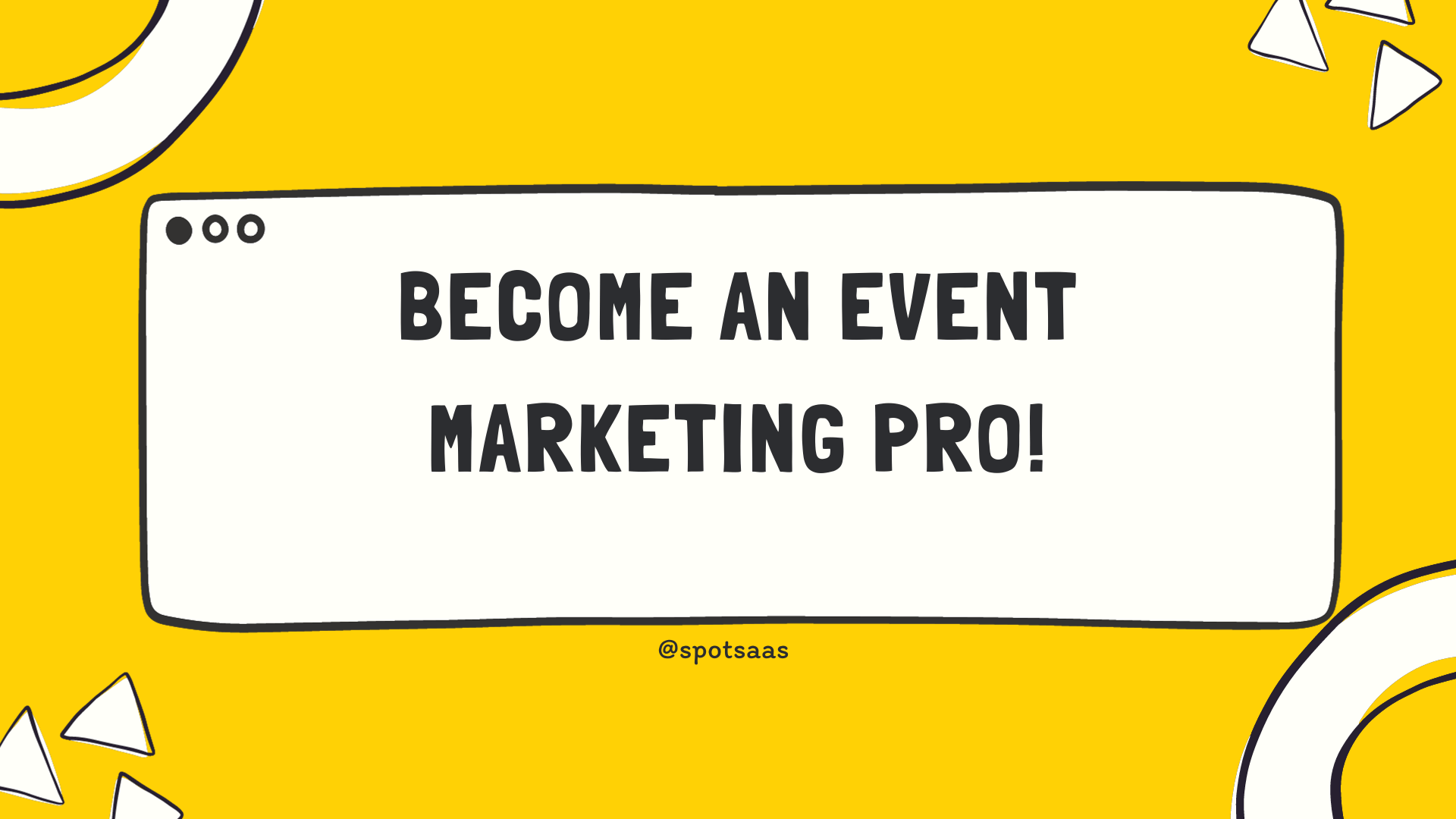EOR software is built to simplify international employment. It allows companies to legally hire, pay, and manage employees in other countries without setting up a local entity. Instead of dealing with separate payroll systems or navigating foreign labor regulations, businesses can operate through a unified platform that ensures everything is handled accurately and in compliance with local laws.
As global expansion becomes a priority for growing businesses, the need for a reliable solution to manage cross-border hiring has never been clearer. EOR software removes operational barriers, giving HR teams and business leaders the confidence to onboard talent from new markets—without slowing down on compliance, contracts, or employee experience.
What This Guide Covers
For companies exploring global hiring solutions, this guide offers a clear overview of how Employer of Record (EOR) software works—and how to choose the right platform for your business.
Here’s what you’ll find inside:
- A breakdown of what EOR software is and how it supports international hiring
- Key features to look for when evaluating providers
- Benefits of using EOR platforms to manage global teams
- Common use cases and challenges to watch for
- Practical steps to choose, implement, and scale with EOR software
- Latest trends shaping the EOR market in 2025
Whether you’re expanding into new regions or building a distributed team for the first time, this guide is designed to help you make an informed, confident choice.
What is Employer of Record (EOR) Software?
Employer of Record (EOR) software helps businesses hire internationally without needing to open a legal entity in each country. Instead of setting up a local branch or navigating complex labor laws on their own, companies can use an EOR platform to handle everything—from onboarding and payroll to compliance and benefits.
At its core, an EOR acts as the legal employer on paper, while the day-to-day work relationship remains between the business and the employee. The software component brings automation, visibility, and control to this arrangement, offering HR teams a centralized place to manage global workers, contracts, taxes, and reporting.
Who Uses EOR Software and Why?
EOR software is used by companies of all sizes that need to hire international talent without the delays or costs of setting up local entities. Whether it’s a fast-scaling startup or a global enterprise, the software helps teams move quickly, stay compliant, and manage remote employees with ease.
| User Type | Why They Use EOR Software |
|---|---|
| 🚀 HR Teams in Startups | Startups can quickly hire global talent without the time or cost of setting up local entities. |
| 🌍 Enterprises Expanding to New Markets | Use EORs to test and grow in new regions before fully investing in a local presence. |
| 💻 Remote-First Companies | Enable distributed teams to work compliantly across borders with accurate payroll and local benefits. |
| 🏢 Companies Without Legal Entities | Avoids the complexity of legal setup, tax filings, and compliance by using EOR as the legal employer. |
HR teams in fast-growing startups
Startups looking to expand internationally often don’t have the resources or time to set up a legal presence in every country they hire from. EOR software gives them a way to bring in talent from new regions quickly—without legal red tape slowing things down.
Enterprises entering new markets
Larger organizations use EOR platforms to test new markets before investing heavily. It’s a practical way to build local teams, gather market insights, and establish a presence—without the upfront cost of forming legal entities in each country.
Remote-first companies hiring globally
Businesses that operate with distributed teams rely on EOR software to onboard and manage talent worldwide. It ensures every team member, regardless of location, is paid accurately and in compliance with local laws.
Companies without in-country legal entities
For businesses that don’t want to deal with entity setup, ongoing tax filings, or labor law changes in each region, EOR platforms offer a complete alternative. The platform handles the local legal responsibility while the business manages the work and team culture.
If your company is planning to grow internationally, wants to expand into new markets quickly, or is building a remote team across borders, EOR software might be the right fit.
Key Features of EOR Software
The right EOR software should reduce complexity—not add to it. While many platforms promise global hiring capabilities, only a few deliver the level of reliability and automation businesses need to scale confidently.
| Feature | What It Does | Why It Matters |
|---|---|---|
| Global Payroll and Tax Compliance | Automates payroll, tax deductions, and filings across multiple countries. | Ensures timely, accurate payments and protects against compliance risks. |
| Localized Contracts and Benefits | Offers compliant contracts and benefits aligned with each country’s laws. | Helps meet legal requirements and enhances employee satisfaction. |
| Automated Onboarding | Streamlines employee setup, contract generation, and document collection. | Accelerates productivity and reduces manual HR workload. |
| Multi-Country Employee Dashboard | Centralizes employee data, payroll, and contract timelines in one view. | Improves visibility and speeds up decision-making for HR teams. |
| Integration with HR/Finance Tools | Connects with existing systems to sync employee and payroll data. | Eliminates data silos and supports seamless workflows across teams. |
Global Payroll and Tax Compliance
Handling payroll across multiple countries requires in-depth knowledge of local tax laws, social contributions, and reporting standards. A reliable EOR platform should automate this entire process—calculating salaries, deducting the right taxes, filing reports, and ensuring employees are paid on time in their local currency.
Why it matters: Payroll compliance isn’t just about accuracy—it’s also about trust. Late or incorrect payments can hurt employee morale and expose your business to legal penalties.
Localized Contracts and Benefits
Each country has different employment laws, mandatory benefits, and contract structures. EOR software should provide ready-to-use, compliant employment contracts based on local regulations, along with access to country-specific benefits like health insurance, retirement plans, and leave entitlements.
Why it matters: Offering localized contracts and benefits helps your company remain compliant while also delivering a competitive employee experience in each market.
Automated Onboarding
A strong onboarding workflow helps teams stay efficient, especially when hiring across time zones. EOR software should automate document collection, contract generation, and employee setup—minimizing manual work while ensuring a smooth start for the employee.
Why it matters: Faster onboarding means new hires can become productive sooner, and your HR team can focus on strategic work rather than chasing paperwork.
Multi-Country Employee Management Dashboard
As you expand into more countries, visibility becomes critical. The software should offer a single dashboard where HR teams can monitor employee statuses, contract timelines, benefits, payroll cycles, and more—all in one view.
Why it matters: A centralized dashboard ensures better oversight, faster decision-making, and less time spent switching between systems or spreadsheets.
Integration with HR and Finance Tools
Your EOR platform should fit into your existing workflows—not force you to build new ones. Look for tools that integrate with EOR systems, payroll tools, or accounting software to sync employee data and simplify reporting.
Why it matters: Integrations reduce duplication, streamline reporting, and make it easier to keep everything in sync as your team grows.
How to Choose the Right EOR Software

Check Country Coverage
Before anything else, confirm that the EOR provider offers support in the countries you’re planning to hire in—now and in the future. This includes not just the ability to employ talent there legally but also managing local tax systems, currency, benefits, and employment law compliance.
If your target country isn’t fully supported, you may face unexpected delays or compliance gaps.
Evaluate Core Features
A solid EOR platform should go beyond just handling payroll. Look for must-have features that simplify onboarding, manage contracts with local legal standards, handle statutory benefits, and give HR teams access to real-time dashboards.
The best tools offer automation where it matters, like document collection, compliance alerts, and payroll calculations, saving your team time while reducing risk. Robust feature sets directly impact how easily your team can scale international operations.
Request a Live Demo
A live walkthrough helps you see how the software functions in real scenarios. Ask for a demo that covers onboarding a new hire, reviewing contract templates, and processing payroll across multiple countries.
Pay attention to how intuitive the interface is, how easily HR teams can navigate tasks, and whether employees have a smooth self-service experience. Use the demo to assess not just functionality but also the responsiveness and knowledge of the team.
Understand Pricing Clearly
EOR pricing can vary significantly between providers. Ask for a breakdown of per-employee monthly costs, any one-time setup or onboarding fees, and how benefits are handled financially. Clarify whether pricing varies by country, role type (contractor vs. employee), or employee count.
Transparent pricing gives you a better sense of ROI and prevents future budget issues. Make sure the contract includes a clear cost structure with no hidden clauses.
Start with a Pilot Hire
Rather than making a full commitment, try onboarding one employee in a country where compliance risk is moderate and timelines are flexible. This allows you to test how well the platform handles contracts, payroll, and communication.
It also gives your team a chance to interact with customer support and experience how issues are resolved. A successful pilot will build internal confidence and validate your provider choice.
Benefits of Using EOR Software
EOR software helps businesses grow faster by simplifying how they hire and manage talent across borders. Instead of spending months setting up legal entities or navigating unfamiliar regulations, companies can focus on building great teams while the platform takes care of the backend.
| Benefit | Why It Matters |
|---|---|
| Faster Hiring in New Countries | Speed is critical in competitive hiring environments. With an EOR solution, teams can secure top candidates quickly without waiting for complex setup processes. |
| Lower Operational Overhead | By outsourcing the legal responsibilities to the platform, companies save on legal fees, accounting services, and internal resources—while still maintaining full control over the working relationship with each hire. |
| Confidence in Compliance | This reduces risk, prevents misclassification, and helps businesses avoid costly fines or disruptions tied to non-compliance. |
| Better Employee Experience with Local Benefits | Employees feel more valued and secure when their compensation and benefits reflect local norms, which can lead to stronger engagement and long-term retention. |
| Scalability for HR Teams | With a scalable system in place, HR leaders can focus on strategy and team development—instead of chasing paperwork or staying updated on local employment laws. |
Faster Hiring in New Countries
Opening a legal entity in a new country can take weeks—or even months. EOR software removes that delay by acting as the legal employer, allowing companies to onboard international talent within days.
Why it matters:
Speed is critical in competitive hiring environments. With an EOR solution, teams can secure top candidates quickly without waiting for complex setup processes.
Lower Operational Overhead
Setting up and maintaining legal entities across multiple countries comes with ongoing legal, financial, and administrative costs. EOR platforms offer a much leaner approach.
Why it matters:
By outsourcing the legal responsibilities to the platform, companies save on legal fees, accounting services, and internal resources—while still maintaining full control over the working relationship with each hire.
Confidence in Compliance
Labor laws, tax rules, and employee classification standards vary from one country to the next. EOR platforms are built to stay updated with local requirements and apply them across your employment processes.
Why it matters:
This reduces risk, prevents misclassification, and helps businesses avoid costly fines or disruptions tied to non-compliance.
Better Employee Experience with Local Benefits
Offering competitive, locally compliant benefits is important for attracting and retaining talent. EOR software ensures employees receive the perks they expect in their country—whether it’s healthcare, paid time off, or pension contributions.
Why it matters:
Employees feel more valued and secure when their compensation and benefits reflect local norms, which can lead to stronger engagement and long-term retention.
Scalability for HR Teams
As companies expand into more countries, HR teams can quickly get overwhelmed by the operational load. EOR platforms help centralize and automate global employment processes, making it easier to manage international teams from one place.
Why it matters:
With a scalable system in place, HR leaders can focus on strategy and team development instead of chasing paperwork or staying updated on local employment laws.
Pricing Models
Understanding how EOR software is priced can help you budget more accurately and avoid surprises later on. While pricing structures can vary by provider, most platforms follow a few standard models based on the number of employees, services offered, and level of support.
Here’s a breakdown of the most common pricing elements:
Monthly Per-Employee Fees
Most EOR platforms charge a fixed monthly fee for each employee hired through the platform. This fee typically covers employment setup, payroll processing, tax filings, and basic HR support. The rate can vary depending on the country, the level of benefits included, and whether the hire is full-time or part-time.
What to expect:
Monthly fees often range from $200 to $700+ per employee, depending on the location and complexity of compliance in that region.
Setup Fees or Onboarding Charges
Some providers include one-time setup costs for each new employee or country. These fees may cover contract preparation, benefits enrollment, or initial compliance checks.
What to expect:
Setup fees can range from a few hundred dollars per employee to country-specific onboarding charges. Others may bundle this into the monthly cost, so it’s important to clarify what’s included.
EOR vs. Global Payroll-Only Tools
Not all global employment platforms offer the same level of service. It’s important to understand the differences between:
- EOR Platforms: Act as the legal employer, handling contracts, taxes, benefits, and compliance. Ideal for companies without local legal entities.
- Global Payroll Tools: Help manage payroll across countries but require you to already have entities established in each location.
- PEOs (Professional Employer Organizations): Typically work through a co-employment model and are best suited for companies operating within their home country or where they already have a legal presence.
EOR vs PEO is a common point of confusion—while both help manage HR and compliance, EORs can legally employ workers in foreign countries where your company has no entity, whereas PEOs require one.
Why it matters:
If your company doesn’t have a local entity in the country you’re hiring in, a payroll tool or PEO won’t be enough. You’ll need a true EOR platform to stay compliant and fulfill employment obligations in that region.
Comparison with Alternatives
EOR software isn’t the only option for managing international teams, but it’s the most comprehensive when legal employment and compliance are involved. To choose the right solution, it helps to use a comparison checklist that outlines how EOR platforms differ from other tools supporting global teams—such as payroll providers, PEOs, or contractor management systems.
| Solution | Key Differences | EOR Advantage |
|---|---|---|
| Global Payroll Providers |
– No legal employment support – Requires local entity setup – Limited help with contracts or benefits |
EOR platforms act as the legal employer, handling contracts, taxes, and compliance for companies without local entities. |
| HRIS Platforms with International Features |
– May support global workflows but not legal employment – Often lack payroll or localized contracts |
EOR software ensures employees are legally employed, paid accurately, and receive compliant benefits—beyond what standard HRIS tools offer. |
| Contractor Management Platforms |
– Great for freelance or project-based workers – No support for full-time employment |
EOR software supports full-time hiring with local benefits and classification accuracy, ideal for long-term workforce planning. |
Global Payroll Providers
These platforms are built to manage international payrolls across multiple countries. They help businesses process salaries, calculate taxes, and handle basic reporting—but they assume the company already has a legal entity established in each country.
Key differences:
- No legal employment support
- Requires local entity setup
- Limited help with contracts or benefits
- Best suited for companies with an established international presence
EOR advantage:
If you don’t have a legal entity in the country you’re hiring from, global payroll providers aren’t enough. EOR platforms act as the legal employer and handle everything from contracts to compliance.
HRIS Platforms with Light International Features
Many HR systems include basic support for managing international employees—such as time tracking, document storage, or employee profiles. But these tools typically don’t handle country-specific compliance, payroll, or benefits.
Key differences:
- It may support international workflows but not legal employment
- Often lack localized contracts or payroll capabilities
- Useful for internal tracking, not external compliance
EOR advantage:
EOR software goes beyond tracking. It covers legal employment, ensuring every hire is fully compliant, paid correctly, and covered under the right benefits.
Contractor Management Platforms
If your team primarily hires freelancers or independent contractors, these platforms help streamline payments, contract generation, and tax documentation. They’re built for flexibility but don’t support full-time employment.
Key differences:
- Ideal for managing short-term or freelance workers
- Doesn’t offer full employment status or benefits
- Doesn’t handle misclassification risks in certain countries
EOR advantage:
When you need to hire full-time employees or offer localized benefits, EOR software is the better choice. It helps avoid misclassification issues and supports long-term team building across borders.
How to Evaluate and Shortlist EOR Software
Choosing the right EOR software is a strategic move—especially if your company plans to scale globally. With several platforms offering similar promises, the evaluation process should go beyond feature checklists.

Here are practical steps to help you shortlist the right EOR provider:
Start with Independent Reviews
Before booking demos, explore what real users are saying on trusted software review sites like Spotsaas, G2, or Capterra. Look for consistent feedback around support quality, ease of use, country coverage, and compliance accuracy.
Why it helps:
Reviews give you insights into actual performance—not just marketing claims. Pay attention to how the software handles edge cases or issues in specific countries.
Request Live Demos
A live demo is the best way to see how the platform works in real time. Ask the sales team to walk you through onboarding, contract generation, payroll processing, and reporting tools.
What to look for:
- Is the interface user-friendly?
- Can the platform scale as you add more countries?
- Are legal documents and contract templates easy to access and customize?
Don’t hesitate to ask tough questions—this is where you can test the depth of the platform and the team’s expertise.
Run a Pilot in a Low-Risk Market
Before committing to a long-term contract, try hiring in one country to experience how the process works end to end. Use this as a trial run to evaluate onboarding speed, payroll accuracy, employee satisfaction, and support responsiveness.
Why it helps:
A pilot allows you to measure how the platform performs with real hires—without fully switching over your global hiring strategy.
Talk to References and Join HR Communities
Ask the vendor for references, ideally from companies in similar industries or of similar size. You can also join HR Slack groups or LinkedIn communities where professionals openly share feedback on EOR platforms.
Why it helps:
Hearing directly from other HR leaders or founders who’ve been through the process can surface key insights you won’t find in marketing materials.
Conclusion
Choosing the right EOR software is a key step for any business looking to hire globally without the complexity of setting up legal entities. The right platform simplifies compliance, speeds up onboarding, and gives your team the tools to manage international employees confidently.
As global workforces become more common, investing in a reliable EOR solution can offer both operational efficiency and peace of mind. By focusing on features, support, and real-world performance, companies can find a partner that grows with them. Whether you’re expanding into one new market or ten, EOR software makes global hiring more practical—and more strategic.
Frequently Asked Questions
What’s the difference between an EOR and a PEO?
An EOR takes full legal responsibility for international hires, while a PEO requires you to have a local entity.
Do I need an EOR if I’m only hiring one international employee?
Yes, EORs are ideal for hiring even a single employee without setting up a legal entity.
Can EOR software support both employees and contractors?
Some EOR platforms support both, but it’s important to confirm this before choosing a provider.
How long does it take to onboard an employee through an EOR platform?
Onboarding typically takes 1–2 weeks, depending on the country and the required documentation.
Is EOR software suitable for long-term international hiring?
Yes, many companies use EOR platforms for stable, long-term global team management.





